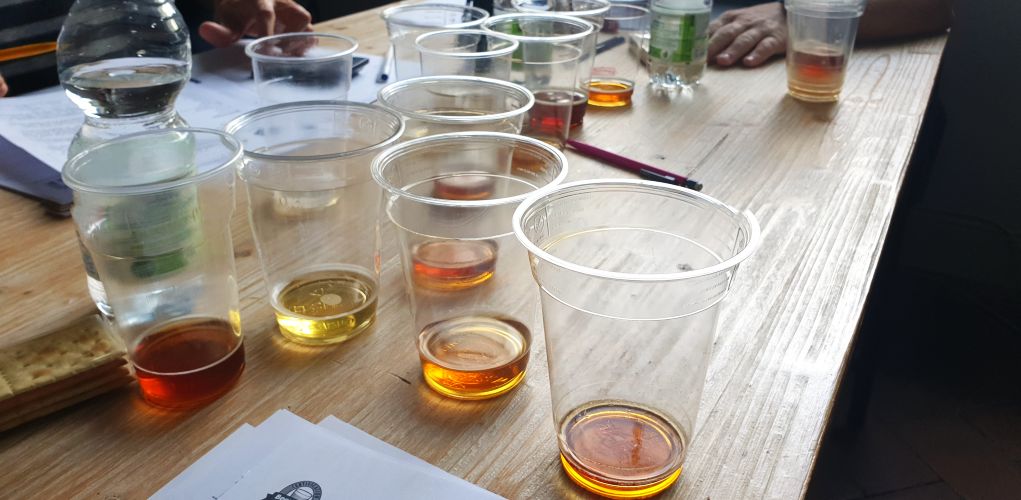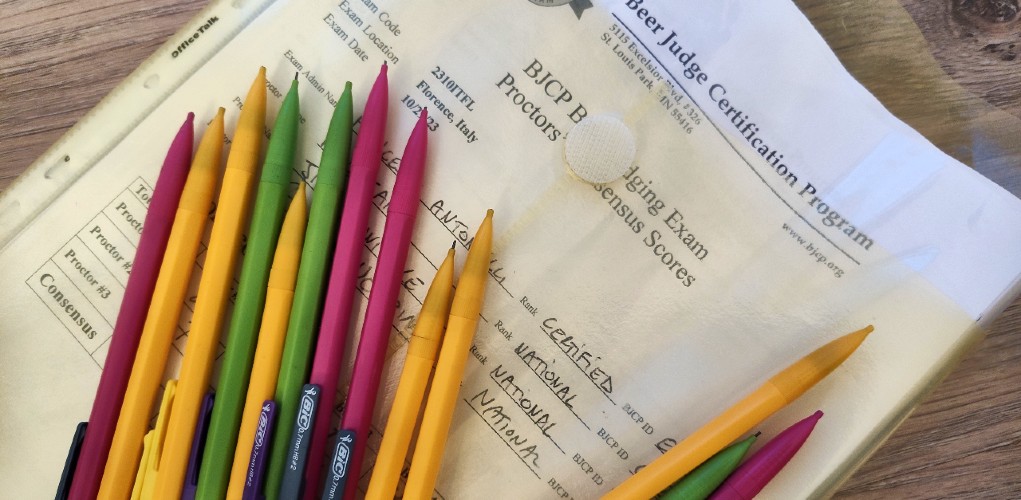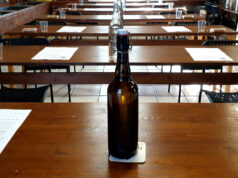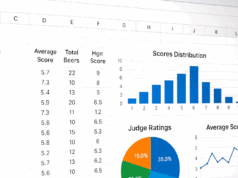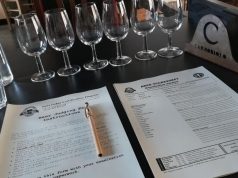I have been part of the BJCP Program since 2017. I live in Italy, where in February 2017 I attended the first BJCP Tasting Exam held in my country. Today I am a Certified BJCP judge with 40 experience points. Last year I attempted the Written Exam; the results should be in soon.
In the past years, I have administered two Tasting Exams here in Italy. The official name of this exam is actually Beer Judging Examination but I will call it Tasting Exam because is a much more familiar name in the BJCP community.
The BJCP Exam Administrator Guide (link) provides a summary of all the admin requirements and exam procedures; you can refer to it at any time for further in-depth details. I’ll provide the most important ones in this post along with some guidance based on my own experience.
Who can admin the Tasting Exam?
Theoretically, only a National or upper-level judge could administer a Tasting Exam. This makes sense because the administrator will also select the six exam beers, which need to have particular characteristics with regard to flavor, taste profile, and scoring.
Nevertheless, a waiver might be given to the administrator if there are no National judges available or if all the local Nationals judges available are proctoring the same exam.
In my case, I organized the two exams as a Certified judge. At the time of my first exam as an admin I had more than 30 experience points and had passed the Tasting Exam with a National grade. I hadn’t taken the Written Exam yet, so I was still a Certified BJCP judge.
I obtained the waiver and began to work on setting up the exam. If you are not a National ranked judge, write to the exam directorate (link) and ask for a waiver before filling up the exam scheduling form.
Scheduling the exam
The exam may not be scheduled for more than 24 months in the future, but it must be scheduled at least four months in advance. I usually make it appear in the official Exam Schedule (link) six to seven months in advance. This should allow candidates enough time to prepare for the exam.
Complete the Exam Data Administration Form and email it to the Calendar office to schedule the exam. Both the form and the email can be easily found on the BJCP Exam Schedule page (link).
Prior to sending the form, you have to identify the potential exam proctors.

How to find the exam proctors
A minimum of two proctors and a maximum of three are needed. Proctors should be at least National level judges. It is preferred that at least one of them is a Master level judge or a National with a scoring of 90 or more at the Tasting Exam.
If there are two proctors and one of them is Master-level, a third Certified-level proctor is allowed to join. On the Tasting Exam, he ought to have received at least an 80/100 and have at least 10 judging experience points.
In Italy, there is only one National-ranked judge at the moment. In the past, it has been permitted for an Italian Certified BJCP judge to proctor with an international Master judge coming from abroad. However, this is not a typical circumstance.
The exam directorate may provide various waivers when a tasting exam is held in an area where there are few or no judges with a higher rank. Proctors are usually not paid or reimbursed, but if they must travel and there is no other option nearby, a budget of up to $500 may be approved to cover their travel costs.
You cand find the list of potential proctors here. My suggestion would be to check availability by sending an email ahead of time to those who are closer to the Tasting Exam location. If necessary, send an email to the exam directorate requesting a budget for travel expenses. Once everything has been finalized, submit the Exam Data Administration form for official approval.
We only have one National here in Italy, therefore I usually ask for an additional waiver for a highly qualified local Certified judge who has a lot of experience. Having already received approval to serve as a proctor, he is able to step in if one of the two designated proctors is unable to attend. It would be difficult (if not utterly impossible) to set up flights and accomodations for a new proctor coming from abroad at the last minute.
What about the exam budget? Let’s delve into that.
The exam budget
Each examinee taking the Tasting Exam for the first time pays $40. The exam fee is waived to $15 if the examinee is already a BJCP member with a BJCP ID (i.e he/she is taking the Tasting Exam again to increase scoring).
70% of the entrance fees must be returned by the administrator to the BJCP. The rest should be enough to cover all the exam expenses. Is it? It depends.
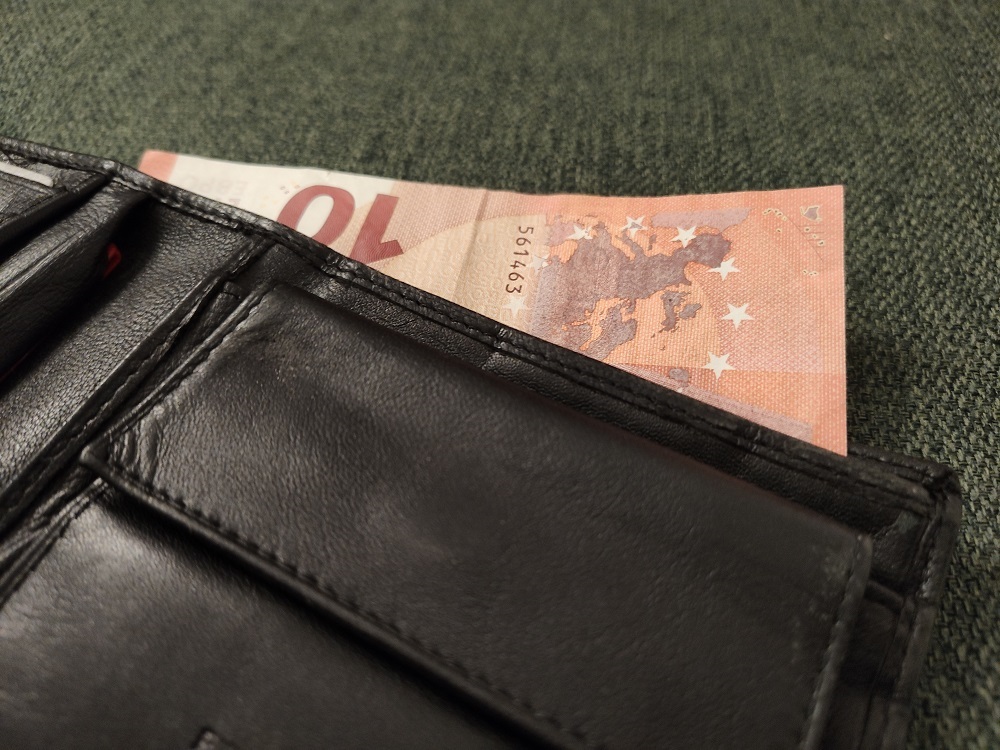
The administrator would need the following materials to administer the test: printed scoresheets (about 100 total, including a few extra for emergencies); 15 pencils; water and crackers to cleanse the palate; a pitcher to mix two liters of beer to deliver even samples; and plastic cups (six for each participant plus the proctors, for a total of about 100). Glasses could be used, however it can be difficult to find a location with 70–80 matching, spotless, little tasting glasses.
Not to mention the beers. There should be six of them, two liters each. They should all be homebrewed, but finding homebrewed beers with the right characteristics for the exam is not easy (more on that later). Usually the beer that is the classic example of a style is a commercial one, and it costs money to buy. Some of the homebrewed beers could require shipping from other cities, which will increase the cost.
How much of a budget are we talking about? It depends on the examinees pool. It can range from $144 (all 12 participants are taking the exam for the first time) to $54 (all the participants are retakers). On average, you’ll probably have $100-$130 to cover all the exam expenses (proctors excluded). It’s not much, but that’s what it is.
As far as I am concerned, I would increase the exam fees. They have been the same for at least 7 years (the first time I took the exam). I think they have been the same for much longer. Meanwhile, prices have skyrocketed everywhere.
Additionally, I believe that retaker fees should be the same as for first-time takers. They use the same supplies as the new takers at the end of the day—pencils, beer, graders, and the like—so I don’t see why they should be charged less. They should be charged more, if anything. They would not be taking the exam again if they had performed better on the first try.
In any case, be very careful with the budget you’ll get. Inform the Exam Director in advance if additional funding is required (for instance, to rent a room for the exam). Although I wouldn’t rely on it, more budget might be allowed.
Collecting fees and examinees data
The exam administrator is in charge of gathering examinees data and exam fees. The examinee must have passed the online entrance exam (link) or be a current member of the BJCP (i.e., an exam retaker) in order to sit for the exam.
Since the maximum number of partecipants is limited to twelve, I usually confirm the enrollment only to participants who have already passed the online exam or are members of the BJCP. I can’t guarantee a spot in the exam if one of these two requirements is not met and the cost isn’t paid.
An exam should have a minimum of six participants and a maximum of twelve. Although exceptions can be made, there will be some restrictions on the admin’s point total if there are fewer than six participants. The administrator must request a dispensation from the exam director in order to hold an exam with more than 12 participants.
The following data are needed for each participant:
- Name and Surname
- Address
- Zip Code
- BJCP ID (or Online Exam certificate ID)
- Phone number
- Country, State, and Area Code
As the administrator, you will attribute an Examinee ID (1-12) to each participant. The Exam ID will be created by the Exam Director. The Exam Director will send you the blank scoresheets and all the forms that need to be filled out.
Selecting and preparing the beers
This is the most critical part of the whole exam administration endeavour. The six beers you select for the exam require complying with a set of predefined rules. Let see what we are talking about.
The six exam beers can be selected among the first 1-26 BJCP styles according to the BJCP 2021 guidelines. Do not use styles from 27 onward.
One of the six beers should be quite off-putting, and one should be really good. Talking numbers, the former should score around 20/50, the latter around 40/50. The remaining four beers can span the whole scoring range, hopefully a couple being mid-range.
A couple of beers should have at least one discernible off-flavour.
For a class of 12 examinees plus 2-3 proctors, 2 liters (half a gallon) per beer would be enough.
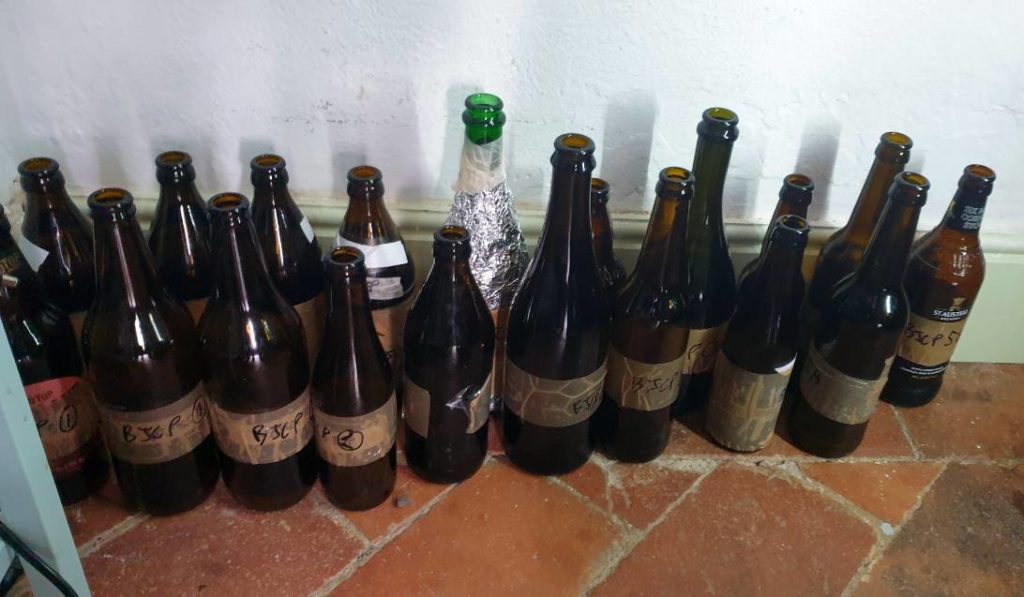
The six beers should cover a broad range of styles, including ale and lagers, different countries of origin, and different styles and colours. A set of choice might be:
- A Bitter with apparent solventy notes and a murky appearance (20/50)
- A German Pils with an off balance. For example, too low bitterness (28/30)
- A fair American IPA (30/50)
- A Belgian Blonde Ale with some oxidation (25/50)
- A good Foreign Export stout (35/50)
- A very good Wee Heavy (40/50)
It takes work since you need to taste the various brews and choose the most suitable ones. It is possible to blend different batches or styles, although caution should be used when doing so. It is tricky to asses the output of a blend if you haven’t already tasted it. I always taste the blends in advance, take note of their proportions, and jot down tasting profiles . This implies having enough bottles at hand before deciding which to put away for the exam.
Being a homebrewer, I often use my beers for the exam. In order to get some “naturally” produced off flavours, sometimes I brew old beer kits, forcing the development of off-flavours. Like fermenting a Pilsner kit in Rome during the summer, when temperatures can easily reach 38°C (100°F).
I purchase a commercial beer solely for the beer that is supposed to score the highest, making sure to taste a bottle of the lot before putting it aside for the exam. If the bottle was not handled correctly, even a great example of a style could have an odd taste.
The exam administrator will ask you to complete a form that includes specific details about each beer’s characteristics, including age, style, aromas, off-flavors, and notes regarding blending and production. For the Exam Director, who needs to approve the set in advance, this is crucial. Additionally, I believe it is important for graders to understand the true nature of the beers.
Working on the beer set ahead of time will allow you to have enough time to choose the appropriate beers and find new ones in case the Exam Director asks you to do so. To ensure that the beers retain their qualities after selection, you need to have adequate room in the refrigerator for them to be stored.
You can find advice on how to doctor the beers here. As I said before, try instead to get already off-tasting homebrewed beers; it would be better to assess the judges ability to find and describe the typical off-flavour found in homebrewed beers.
The BJCP suggests collecting beers from homebrewing competitions, but it seems like a lot of work to me. A single entry consists in no more than 1.5 liters of beer, which is insufficient for the BJCP exam. Furthermore, throughout the judging rounds, at least one bottle will be opened, meaning you won’t have more than one liter remaining. It is possible to combine various beers in a blend, but this would require tasting beforehand, which would further reduce the quantity of beer remaining. In addition to that, as I typically travel to competitions by train or plane, I would find it extremely difficult to pick up the remaining bottles and bring them home. For all this reasons, I usually don’t rely on leftover beers from competitions.
Exam day: practical tips
Create a checklist of everything you’ll need for the exam and review it multiple times in the days leading up to the test. Before you leave your house on exam day, make sure to check it again.
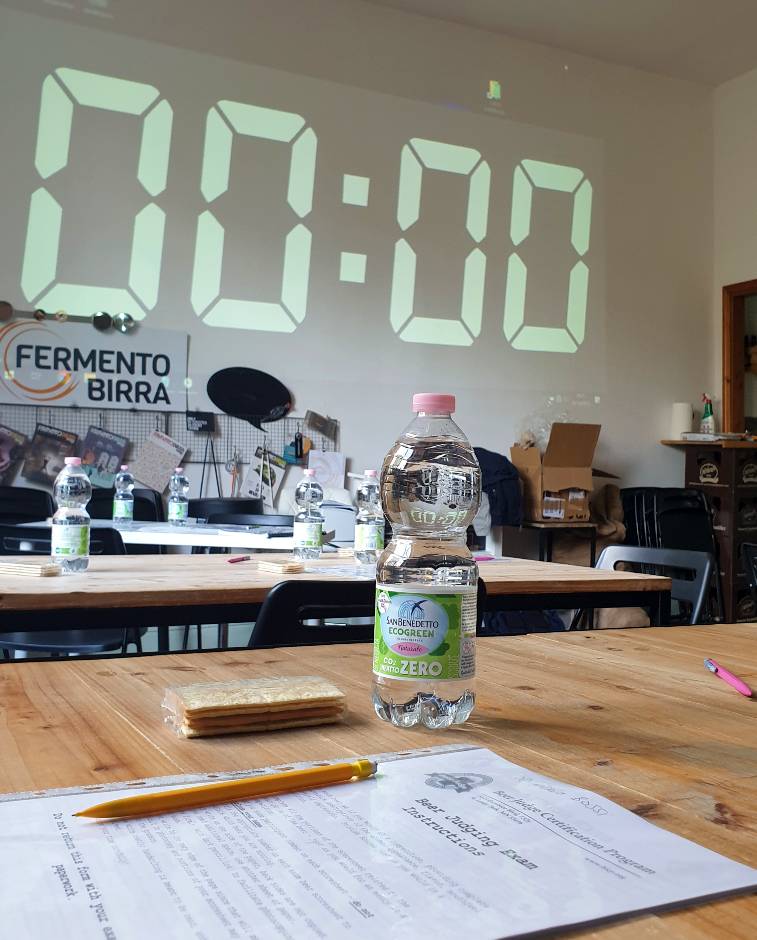
Essential items to bring with you:
- exam beers
- bottle opener
- pitcher
- examiness scoresheet
- proctors scoresheet
- proctors consensus sheet
- pencils
- plastic cups (if you are going to use plastic)
- crackers and water (to cleanse the palate)
I strongly advise you to print extra sheets and carry extra pencils and extra plastic cups, just in case. You won’t have time to look for additional stuff during the exam.
Optional but very useful items to bring with you:
- a stopwatch or clock to keep track of the time. It would be ideal if it were large enough for everyone in the room to use (a laptop monitor would work well)
- additional blank sheets, which some examinees utilize to jot down notes
- a tray (used for setting out glasses on tables)
- a stapler
- a few plastic sheet protectors (used to gather scoresheets from each proctor and each examinee)
The Tasting Exam lasts one hour and a half. Mistakes cannot occur since the clock is always ticking. Every fifteen minutes, you (and preferably someone who assists you) will have to serve one beer. Each bottle should be carefully poured into a large pitcher before serving to balance out any variations in flavor.
To prevent any problems with foaming, begin pouring far in advance of serving a beer that has a lively or excessively high carbonation level. If the temperature in the refrigerator is too low, take out the bottles from the fridge well ahead of serving time.
The beers are served at 15-minute intervals. Leave the glass from the previous round at the tables, don’t take it back. When each beer has two minutes remaining, give a warning to the room. List each beer’s style name and number on a piece of paper and display it to the group. If possible, leave it visible for the whole time while the beer is being tasted.
Ensure that every examinee has completed the scoresheets with alle the beer’s numbers and their exam code when the allotted time runs out. Gather all the papers and count them twice or more to be sure nothing is missing. As soon as you can, bring the papers home and store them together in a secure location. If you lost any of them, the exam is screwed. Make sure all the paperwork are in safe hands before you go to relax and have a few beers.
The BJCP handbook advises minimizing post-test conversations with the proctors regarding exam beers. I believe it makes sense because giving examinees too much information could lead to erroneous expectations. But I believe it’s entertaining and thought-provoking to have a little conversation about the beers that were served and the proctors’ opinions about them.
After the exam
The scoresheets must be scanned using a suitable scanner according to the BJCP rulebook, although a modern cellphone will work just as well. I utilize the Google Drive scanning feature, which turns a picture of the scoresheet into a PDF automatically. It uploads the image straight to the cloud, removing shadows and cropping it to perfection.
To put the six scans of each examinee (or proctor) together into a single pdf file, I use the free online tool I Love PDF. All the files should follow the BJCP naming convention, which is quite straightforward. You can find it in the BJCP Exam Administrator Guide (link).
After scanning is complete, open the Admin Data Report xls file and fill in the “Scoring Data” sheet. Next, provide the Exam Director access to the examinees’ scoresheet, the proctors’ scoresheet, the proctor consensus sheet, and the admin data report. It can be easily done sharing a Google Drive or Dropbox folder which contains all the documents. All this process should be completed within a week of the exam date.
Until the exam grading is completed, the exam papers need to be stored in a secure location. In the event that a sheet is difficult for the graders to read, the exam administrator may request more scans.
Finally, go to this page to transfer 70% of the exam fees to the BJCP.
Is it worth it?
You will receive 10 GMSR credits and 2 non-judging points for administering a Tasting Exam. Not much, given the work involved, but that’s not the main idea.
Reading every one of the exam scoresheets afterward is, in my opinion, the most educational aspect of administering a Tasting Exam. Seldom will you find so many scoresheets with such thorough annotations regarding a beer.
You’ll discover how bias can influence your assessment of certain beers and how a blind tasting can provide a wealth of information about a beer. Of course, there will be some off-track scoresheets, but with such a large database at your disposal, a lot of information can be gathered and analyzed.
For this reason, I frequently select one or two of my brews to be part of the exam beer set. Having all those scoresheets for a beer I produced is invaluable. And yes, it is definitely worth it. You’ll end up with deeper knowledge about beer and tasting, even if you did not take the exam yourself.
